Challenges Faced by Vietnamese Learners in IELTS Speaking: More Than Just Language Problems
Phuong Thi Anh LE, Vietnam
Dr. Phuong Le, presently working at Phu Yen University, Vietnam, has been involved in EFL teaching and teacher education for 37 years. She has numerous conference presentations and published articles on EFL issues in different international journals. Her current professional interests include developing students’ creativity, critical thinking skills and EFL assessment. Email: leaphuong2003@yahoo.com
Menu
Background
Methodology
Results
Discussion
Conclusions
References
Appendix I: Questionnaire
Appendix II: Sample tests
In the globalised world, English is becoming more and more common because it is used for more purposes and by more people (Taavitsainen & Pahta , 2003). Specifically, the increasing popularity of this language can be witnessed in its use as a language of instruction in many educational programs, especially those targeting at overseas students (Marginson & Van De Wende, 2007), as well as in the mass media and entertainment (Taavitsainen & Pahta , 2003). In fact, English is now used not only among and with English native speakers of English, but also among non-native English speakers (Rajabi & Ketabi, 2012).
In Vietnam, national development in the globalised world requires Vietnamese students and staff to improve their English competence for communication and work purposes in multicultural and multilingual environments. Also, the trend towards standardization for English language competence has increased the number of Vietnamese test takers of the International English Language Testing System (IELTS). Both students and professionals take this test as an English language requirement in their search for overseas studies, work opportunities or career advancement. Of all the four skills in the IELTS, Vietnamese learners often find listening and speaking skills more challenging perhaps due to the lack of exposure to the target language and opportunities to practise these skills (Le, 2014). Teachers of English also consider it hard to help Vietnamese learners develop these skills for IELTS (Nguyen, 2010). In this context, it is deemed a useful task to explore the challenges faced by Vietnamese learners in taking the IELTS speaking tests in order to provide some useful insights to both teachers and learners so that they can develop adequate strategies for IELTS Speaking tests in particular and effective learning of English in general.
Research question
Each IELTS Speaking test often lasts between 11 to 14 minutes divided among three parts. Part One can be considered the easiest one when the candidate has to answer general questions on familiar subjects while in Part Two, the candidate is expected to talk on a given topic on a card with some guided questions and to answer one or two follow-up questions. Part Three is generally the most challenging when the candidate is engaged in a discussion about more abstract issues related to the topic in Part Two.
Therefore, a small-scale study was designed to explore the learners’ perspectives about the factors that can make this Speaking test challenging to them. The research question was, “What makes Part One of IELTS Speaking tests difficult for Vietnamese learners?”
The choice of Part One, and not Part Two or Part Three, was aimed to identify the causes for the challenges of this part, considering that it is the simplest part of the test. Another reason was that one group of participants, who were new on the course, had not had any experience of Part Two and Three when the questionnaire was conducted.
Questionnaire
A questionnaire (Appendix I) with three main sections (A, B and C) was conducted in the respondents’ mother tongue. Section A sought participants’ factual personal information regarding age, gender, occupation, English learning (including IELTS experience). Section B consisted of six questions to explore the general difficulty of the test and to identify factors that might hinder their successful performance of the test. Section C investigated respondents’ perceptions of four specific test samples (Appendix II).
The difficulty level of the test was measured against a five-level Likert scale from 1 to 5, with 5 being the highest and 1 the lowest (5 very difficult, 4 difficult, 3 fairly difficult, 2 slightly difficult and 1 not difficult at all). To further clarify the core data, some written recording of participants’ oral responses during practice of sample Speaking tests used in the questionnaire was added.
Participants
The subjects in this case study were two separate groups of learners who were doing an IELTS course taught by the researcher, with three weekly lessons of 90 minutes each for four macro language skills. At the time of the study, Group ONE (20 participants) had been taking the course for 6 months so they had some practice with all parts of the Speaking skills while Group TWO (23 participants) had been on the course for only one month and received some practice only for Part One of the tests.
These groups were very much similar, regarding their gender, age and occupation patterns. Specifically, both comprised more females than males (15 and 5 respectively in Group ONE vs. 15 and 8 respectively in Group TWO). The occupation pattern showed mostly school students (11 and 10 respectively) and university students (5 and 10 respectively), apart from some working people (teacher, accountant, engineer, office worker and soldier).
Most school students had more English learning experience (3 to 9 years at school, private or evening classes) than university counterparts (3 to 5 years at similar institutions). Especially, nearly one third of Group ONE (6/20) possessed certain certificates (B1, IELTS, or TOEIC). Therefore, these groups were hereinafter sometimes referred to as more experienced group/participants and less experienced group/ participants accordingly. These respondents took the current IELTS course mainly to be qualified for overseas study, apart from a smaller group aiming at university education and job/promotion opportunities.
The participants took part in the survey on a voluntary basis, filling out the questionnaire in a routine class and the researcher went through the questionnaire and provided necessary guidance to avoid any misunderstanding. After collection, the results were recorded and organized into three groups, represented in columns A, B and C.
- Column A consisted of the number of all raw responses in each Likert category, ranging from the highest score (5) to the lowest one (1) on Likert scale for Groups ONE and TWO as in the following example.
5(1) + 4(7) + 3(11) + 2(1)
- Column B (≥ 3) indicates results for all responses with scores from 3 to 5. In the analysis, this group of responses was interpreted as meaning that the issue/item was difficult.
- Column C (≥4) separates the rate of those responses in column B with scores of 4 and 5 in order to highlight the higher level of difficulty for some aspects.
1. How difficult is it to understand the questions in Part One?
While only about one third respondents (6/20) in Group ONE considered understanding questions fairly difficult, this number in Group TWO was nearly a half (12/23).

2. How difficult is it to answer the questions in Part One?
Group ONE found it not very difficult to answer or understand questions, with one third of the participants giving it a score of 3. In contrast, there were remarkable differences in Group TWO with half of the group scoring ≥ 3 for understanding, compared to almost all giving this score to the task of answering questions, of which 9/23 rating it ≥ 4. This shows that response to questions was more challenging to Group TWO than Group ONE.

3. How difficult are the following aspects in understanding questions in Part One?
- Vocabulary
- Grammar
- Pronunciation
- Speed
- Content
- Others (Be specific)
Though most experienced participants did not consider understanding questions a difficult task, it was still a challenge to a third of the group, mainly because of content, vocabulary and pronunciation. Content was regarded as the biggest difficulty to nearly all Group ONE, with half of whom making it ≥ 4. Second to this was vocabulary with most of them giving it ≥ 3, of which many were ≥ 4, followed by pronunciation with nearly half of the group confirming this difficulty. By contrast, most did not have much trouble with speed and grammar of the questions.
Less experienced participants, however, generally found all these factors difficult. Scores of ≥ 3 were given to vocabulary and content by most of them, especially to half of Group TWO (≥ 4). By comparison, though grammar, speed and pronunciation were less troublesome, they were still a concern to half of the group. Particularly, a quarter of this group still rated grammar and pronunciation ≥ 4.
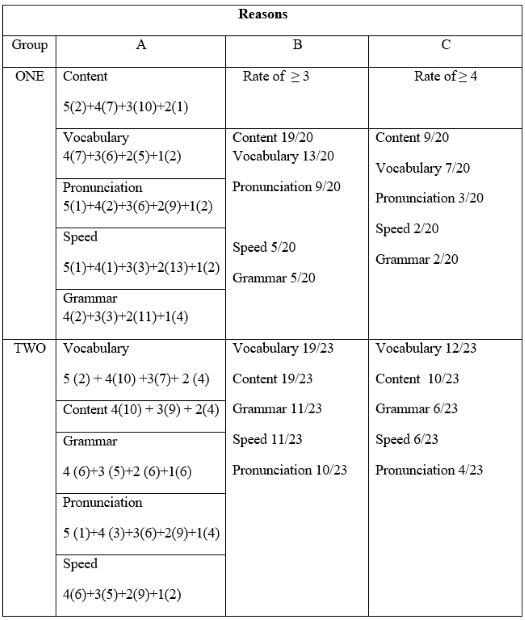
4. How difficult are the following aspects in answering questions in Part One?
- Lack of ideas
- Idea expansion
- Vocabulary and grammar
- Fluency
Both ideas and language created problems for both groups with significant number of respondents claiming this, especially in Group TWO. In fact, half of the group found it very challenging ≥4 and this population gave it ≥3 was even bigger. Interestingly, Group ONE found generating ideas more challenging than language while it was the opposite in Group TWO
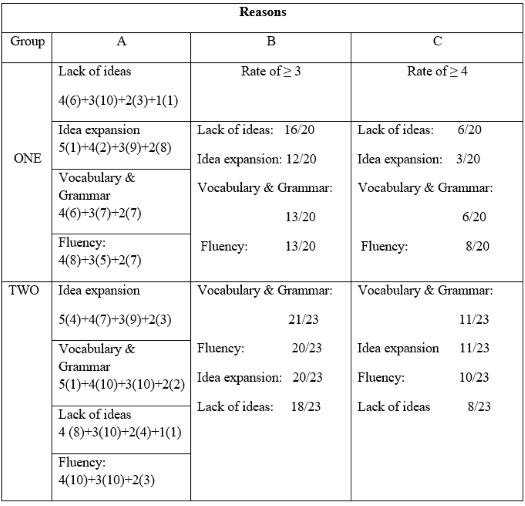
5. How difficult are the following aspects in answering questions in Part One?
- Time
- Confidence
- Eye contact
- Voice
Apart from idea and linguistic issues, time (immediate response in answering) seemed to pose a serious challenge to most respondents in both groups whereas their soft voice was a problem to fewer respondents. Also, confidence and eye contact were a weakness to many less experienced learners.
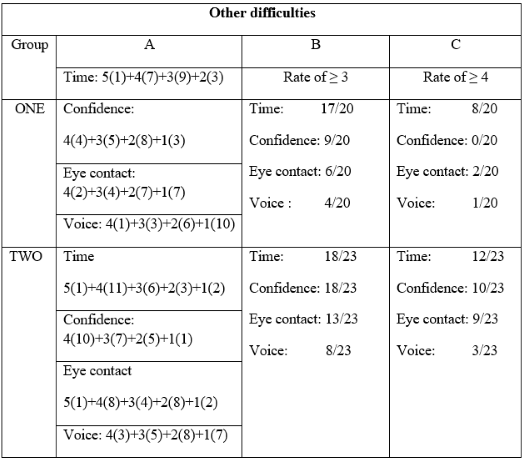
The difficulty posed by the question content was further clarified by the participants’ perceptions about four test samples. As indicated, results showed that both groups found tests 1 and 2 less troublesome than tests 3 and 4 but it is worth pointing out the proportion of respondents found the last two tests’ difficulty was higher.
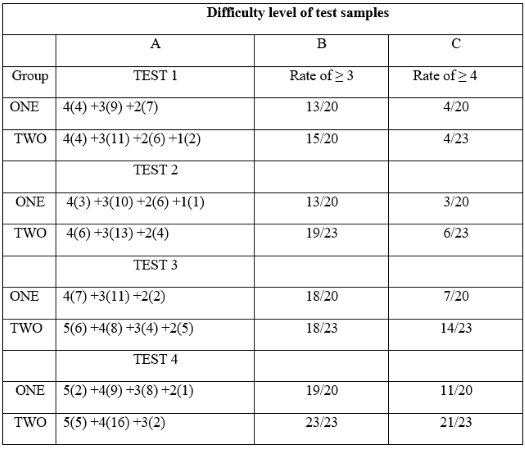
Dealing with general topics in Part One of IELTS Speaking tests was difficult to the participants for various reasons. The lack of language exposure and practice of Speaking skills in foreign language environment in Vietnam, coupled with the large classes of approximately forty students in school and university classes was definitely a disadvantage. In this context, there is no doubt that school textbooks and methods of teaching, learning and assessment which still focused more on language components, rather than skill development were to blame for this. These limitations somehow hindered the learners’ ability to communicate naturally in English despite some learners’ access to evening language centres where English is often taught with internationally used textbooks published by Oxford, Cambridge or other international publishers.
Further exploration into this problem revealed that understanding questions was sometimes the first barrier for the participants’ and this certainly led to their challenges in answering the questions, especially for the less experienced group. As pointed out by the respondents, question content was a leading factor in making questions incomprehensible, followed by vocabulary and pronunciation. This difficulty might have resulted from the way some questions were worded, which was different from the way they were familiar with, such as those in the following samples.
- Are you a morning or an afternoon person? (test 1)
- How would you react to receiving a dictionary as a gift?
(test 1)
- What aspect is important for you when choosing clothes?
(test 2)
Undeniably, these questions were cognitively much more difficult to encode than the rephrased ones, like
- Do you study more effectively in the morning or in the afternoon?
- Do you feel happy when you are given a dictionary?
- Which of these aspects is important to you in buying clothes, price, design, colours or something else?
Though the original questions were more concise than the paraphrased ones, they were less comprehensible to the learners who might have wondered about what was asked. Some other examples can illustrate the subjects’ difficulty in understanding the questions.
- What significance do birthday celebrations have in your country?
(test 3)
- What is the significance of birthdays in one’s life?
(test 3)
It was also true that the concepts raised in these questions were unfamiliar to many participants. Specifically, the idea of being given a dictionary might have required Vietnamese learners some time to think of a satisfactory answer because many high school students did not have a dictionary themselves and it seemed that receiving a gift of a dictionary was not a very common practice in various contexts because it might be an expensive gift. Also, school teachers usually provided them with meanings for new vocabulary in lessons. Similarly, not many Vietnamese learners celebrated their birthdays and some might have never attended one. Cognitively, they might have never thought about the significance of birthday celebrations so they might find it hard to provide a timely and adequate answer in English. Further examples in sample test 4 about people’s attitudes to teenagers or their relationship with adults tended to be far beyond the cognitive ability of many Vietnamese learners.
- How does the society look upon teenagers?
(test 4).
- Are teenagers being given more lenience?
(test 4)
- What kinds of misunderstanding happen between teenagers and adults?
(test 4)
Another aspect worth mentioning was the use of vocabulary in some questions. Words like ‘react’, ‘significance’, ‘aspect’, ‘lenience’ and ‘look upon’ could be either new or too sophisticated for some participants who might have found simplified forms of these questions more manageable. For example,
- Why do people in your country organise birthday parties?
- Is the birthday important to a person?
- Are adults more or less strict with teenagers?
- What do people think about teenagers in your society?
It is worth pointing out that even when the questions were understood, responding to them was still a big challenge to the subjects. One cause was related to participants’ limited ability in idea generation and expression. The lack of ideas not only made the responses less interesting but it also strongly affected the linguistic quality of the answers. This means that the participants gave only simple or a limited range of vocabulary and grammar in the answers. This drawback may have related to their limitations in thinking skills and communication skills. As observed, it was normal for learners to produce linguistically simple replies, with basic words, without any explanation or examples, in addition to repetition of the question, nearly word for word. Class observations witnessed examples like:
Q: Do you help others to choose clothes?
A: No, I don’t help others to choose clothes.
Q: What kinds of clothes do you wear?
A: The kind of clothes I wear is uniform.
It seemed clear in these examples that the learners failed to understand that it was crucial for them in these cases to elaborate their answers, justifying and substantiating their response with further details about reasons and examples for choices to show not only their general knowledge about common topics, but also their language richness in terms of vocabulary and grammar. Their inadequate answers might have been deep rooted in the way of school teaching which put high emphasis on correct grammar and vocabulary, rather than effective communication. This negative effect was so strong that the learners repeatedly manifested this weakness and it often took a long time with constant practice and repeated reminders for them to get rid of this undesirable experience.
Time factor was another aspect that made effective oral responses a challenge. The necessity to understand the questions instantly and to respond adequately put a serious pressure on the part of the test takers. They first had to decode the words they heard to understand the questions before they thought of ideas, rearranged them to formulate a response. This process was not easy at all for the learners who were not trained for these skills in an environment like Vietnamese schools where high order thinking skills seemed to receive very little attention, especially in English language classes. Therefore, apart from idea and linguistic problems, time also posed a serious challenge to most respondents who found the requirement of an immediate response in oral interaction a real pressure.
Considering the learners’ limited English, the task of transferring their mother tongue, which was more developed than their English, into the target language was a big hindrance. Actually, as a teenager or young adult, their mother tongue was significantly more sophisticated and complicated than their English competence, especially when they lacked the essential strategies for conveying their ideas from one language to another so their translation of what they meant to say did not work effectively. In fact, successful language learners need the cognitive capacity to select, simplify, paraphrase, summarise and organise what they want to say to make themselves understood. Unfortunately, Vietnamese learners often lack these abilities as often witnessed in their foreign language performance and a common strategy that they use is direct translation from their mother tongue into the target language, which often ended in some confusion. This limitation often happens when the learners face difficult questions or when they are in exam contexts where worry or stress is an issue.
Other limitations in expressing ideas are due to inadequate explaining, or elaborating skills which also resulted in poorer coherence and cohesion in longer responses and learners’ extended responses were often awkward or made little sense.
Q: What was your favourite subject at school? Why?
A: My favourite subject at school was Math. My teacher and my friends are very good. Q: How often do you use a dictionary? Why?
A: I sometimes use a dictionary because I need it.
Q: Did your taste in music change since you were younger?
A: I liked music change since I was younger because I am grow. Music pop noisy.
Q: Do you think young people are less interested in the news than older people?
A: Young people not interested newspaper. They read the Internet more than old people.
As pointed out by Le (2013), Vietnamese learners were often weak in thinking skills which might have resulted from the negligence of these skills in their education. The impact of these thinking skills which encompass those skills in Bloom’s taxonomy for knowledge, comprehension, application, analysis, synthesis and evaluation (Igbaria, 2013) on learners’ speaking proficiency has been confirmed (Sanavi & Tarighat, 2014). The limitations in thinking skills could have been partly blamed for the learners’ difficulty with Part One of the Speaking tests in this case study. In addition, lack of confidence as shown in limited eye contact or mumbling voice also added further weaknesses in their performance.
In short, the results of this case study shed some light into the challenge of IELTS Speaking tests to this group of Vietnamese learners, even with the simplest part of the test which has been designed to be general questions about familiar topics. In this survey, apart from linguistic factors, cultural incompatibility between the test designers and the test takers in various parts of the world could pose some difficulty, considering that IELTS is a test designed for a worldwide population of test takers. Also, it is worth mentioning that Vietnamese learners' lack of general knowledge and high order thinking skills, such as elaboration, explanation, organisation, analysis and evaluation significantly affected the learners' language performance. This might have ended in ineffective answers both in content and language richness.
These findings were hoped to raise the awareness about specific obstacles that the learners might face in internationally standardised tests and help language teachers and learners make informed decisions about adequate measures to improve Vietnamese learners’ English capacity in the globalised world. It is suggested that more attention should be paid to developing learners’ various thinking skills and cultural understanding, apart from linguistic factors. Language learners also need to learn the language to clarify their ideas (i.e. Let me put it in another way), to ask for clarification (i.e. Could you explain what you mean by…?) or the language of filling the silence when they have not found out the suitable words (i.e. What’s the word?) or to end an answer (i.e. That’s all I can say about that.) to make their language sound natural.
Also, since critical thinking skills are highly valued in modern society, training and teaching materials to improve these skills for the learners’ should receive proper attention to make Vietnamese learners not only more effective in their language learning and competent language users but also competitive source of working force.
As this study involved the data from a small population in a city in Vietnam, it is strongly recommended that further studies with a wider group in various non-native English contexts should be done to explore these issues in depth. In this way, more useful insights and contributions can be gained to enhance the efficiency of learning and teaching English in the non-native English world.
Igbaria, A. K. (2013). A Content Analysis of the WH-Questions in the EFL Textbook of
Horizons. International Education Studies; Vol. 6, No. 7, 200-224.
Le, T.A.P. (2013). Academic Problems Faced by Vietnamese Tertiary Students in Australia. Paper presented at 2013 International Conference ‘Impact of Globalisation on Quality of Higher Education’. June, 20-21, Ho chi Minh city, Vietnam. Retrieved from http://www.vnseameo.org/InternationalConference2014/program.php
Le, T.A.P. (2014). Improving school teachers' capacity: Insiders' perceptions. Paper
presented at 2014 International Conference ‘Leadership and Management in Higher
Education for Sustainable Development. July, 24-25, Ho chi Minh city, Vietnam. Retrieved from http://www.vnseameo.org/InternationalConference2014/program.php
Marginson, S. & Van De Wende, M. (2007). Globalisation and Higher Education. (Education Working Paper No. 8). Centre for Educational Research and Innovation. Organisation for Economic Co-operation and Development, EDU/WKP 3.
Nguyen, Q. T. (2010). Difficulties experienced by Vietnamese lecturers teaching IELTS speaking at university level and some suggested solutions. VNU Journal of Science, Foreign Languages 26 (2010) 252-256
Rajabi, S. & Ketabi,S. (2012). Aspects of Cultural Elements in Prominent English Textbooks for EFL Setting. Theory and Practice in Language Studies,2(4), 705-712.
Sanavi, R.V. & Tarighat, S. (2014). Critical Thinking and Speaking Proficiency: A Mixed-method Study. Theory and Practice in Language Studies, 4(1), 79-87.
Taavitsainen, I & Pahta, P. (2003). English in Finland: Globalisation, Language Awareness and Questions of Identity. English Today 76, 19(4).
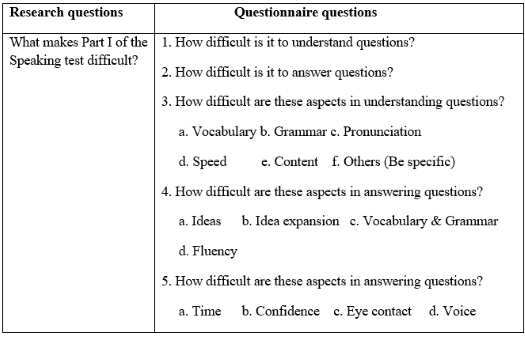
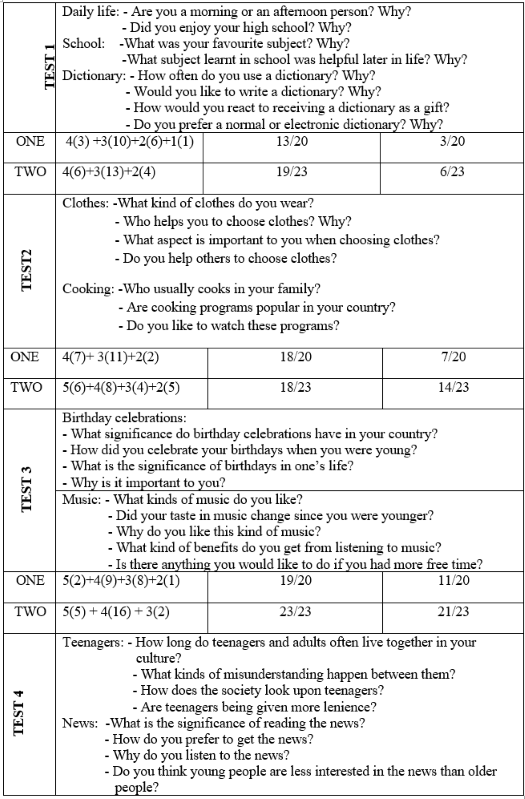

Please check the Teaching Difficult Learners course at Pilgrims website.
Please check the Assessment for the 21st Century English Classroom course at Pilgrims website.
Please check the Teaching Advanced Students course at Pilgrims website.


|